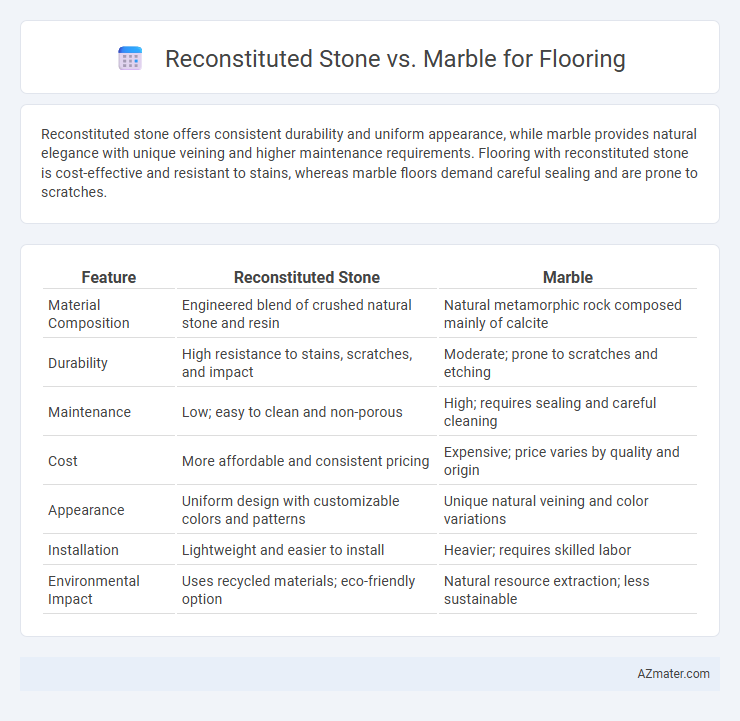Reconstituted stone offers consistent durability and uniform appearance, while marble provides natural elegance with unique veining and higher maintenance requirements. Flooring with reconstituted stone is cost-effective and resistant to stains, whereas marble floors demand careful sealing and are prone to scratches.
Table of Comparison
| Feature | Reconstituted Stone | Marble |
|---|---|---|
| Material Composition | Engineered blend of crushed natural stone and resin | Natural metamorphic rock composed mainly of calcite |
| Durability | High resistance to stains, scratches, and impact | Moderate; prone to scratches and etching |
| Maintenance | Low; easy to clean and non-porous | High; requires sealing and careful cleaning |
| Cost | More affordable and consistent pricing | Expensive; price varies by quality and origin |
| Appearance | Uniform design with customizable colors and patterns | Unique natural veining and color variations |
| Installation | Lightweight and easier to install | Heavier; requires skilled labor |
| Environmental Impact | Uses recycled materials; eco-friendly option | Natural resource extraction; less sustainable |
Introduction to Reconstituted Stone and Marble Flooring
Reconstituted stone flooring combines natural stone particles with resin and pigments, offering durability and design versatility while mimicking the appearance of genuine marble. Marble flooring, formed from metamorphic limestone, is prized for its unique veining and luxurious aesthetic but requires regular maintenance due to porosity. Both materials provide elegant options, with reconstituted stone presenting cost-effective, consistent patterns and marble delivering timeless, natural beauty.
Composition and Manufacturing Process
Reconstituted stone flooring is made by blending crushed natural stone with resins and pigments, ensuring consistent color and pattern, whereas marble is a natural metamorphic rock composed mainly of calcite with unique veining formed through geological processes. The manufacturing process of reconstituted stone involves molding and curing under controlled conditions to achieve uniform strength and finish, contrasting with marble which is quarried and cut directly from large slabs. This engineered approach offers greater versatility and durability compared to the natural variability and porosity of marble.
Aesthetic Differences: Looks and Finish
Reconstituted stone offers a consistent appearance with uniform color and pattern, making it ideal for modern, sleek flooring designs, while marble features unique veining and natural imperfections that create a luxurious and timeless aesthetic. The finish on reconstituted stone is often more controlled and can range from polished to matte, whereas marble typically showcases a high-gloss polish that enhances its depth and natural beauty. Marble's organic variations provide a distinctive, elegant ambiance, contrasting with the engineered predictability of reconstituted stone's surface.
Durability and Lifespan Comparison
Reconstituted stone offers enhanced durability compared to natural marble due to its engineered composition, making it more resistant to cracks, chips, and stains from daily wear. Marble, while elegant and timeless, is softer and more porous, requiring regular sealing to prevent damage from moisture and heavy foot traffic. The lifespan of reconstituted stone typically exceeds that of marble in high-traffic areas, maintaining its appearance with less maintenance over time.
Maintenance Requirements and Care
Reconstituted stone flooring demands less maintenance than natural marble, as it is more resistant to staining, scratching, and etching, requiring only regular cleaning with mild detergents and occasional resealing to maintain its durability. Marble floors need frequent sealing and prompt cleaning to prevent damage from acidic substances and everyday wear, with periodic professional polishing to restore their original shine. Choosing reconstituted stone reduces long-term maintenance efforts and costs, making it ideal for high-traffic areas prone to spills and dirt.
Installation Process and Complexity
Reconstituted stone flooring offers a streamlined installation process due to its uniform size and thinner slabs, reducing labor time and minimizing the need for specialized tools compared to natural marble. Marble requires precise cutting and skilled craftsmanship to handle its irregularities and thickness, increasing installation complexity and time. Choosing reconstituted stone can significantly lower installation difficulties and costs while maintaining a high-end aesthetic.
Cost Analysis: Reconstituted Stone vs Marble
Reconstituted stone offers a more cost-effective flooring solution compared to natural marble, with prices typically 30-50% lower due to its synthetic manufacturing process. Marble flooring involves higher expenses not only for raw materials but also for installation and maintenance, given its porosity and susceptibility to staining. Long-term cost analysis favors reconstituted stone as it combines durability and low upkeep costs, making it a budget-friendly alternative to premium marble floors.
Environmental Impact and Sustainability
Reconstituted stone flooring offers a more sustainable option compared to natural marble, as it is manufactured using recycled stone materials and industrial by-products, reducing the environmental footprint associated with quarrying. Marble extraction leads to significant habitat destruction, high energy consumption, and carbon emissions, whereas reconstituted stone production consumes less energy and promotes waste reduction. Choosing reconstituted stone supports eco-friendly construction practices while maintaining aesthetic qualities similar to natural marble.
Suitability for Different Spaces
Reconstituted stone offers superior durability and resistance to stains and scratches, making it ideal for high-traffic commercial spaces and kitchens. Marble provides a luxurious and timeless aesthetic but requires regular sealing and maintenance, better suited for low-traffic areas like living rooms or bedrooms. Both materials can enhance flooring design, but suitability depends on balancing durability needs with desired elegance and upkeep commitment.
Pros and Cons Summary
Reconstituted stone offers durability, consistent appearance, and lower cost compared to natural marble, making it a practical choice for flooring with resistance to stains and scratches. Marble provides timeless elegance, unique veining, and natural beauty but is prone to scratching, staining, and requires regular maintenance. Choosing between reconstituted stone and marble involves balancing budget, aesthetic preference, and long-term durability needs.

Infographic: Reconstituted stone vs Marble for Flooring
 azmater.com
azmater.com